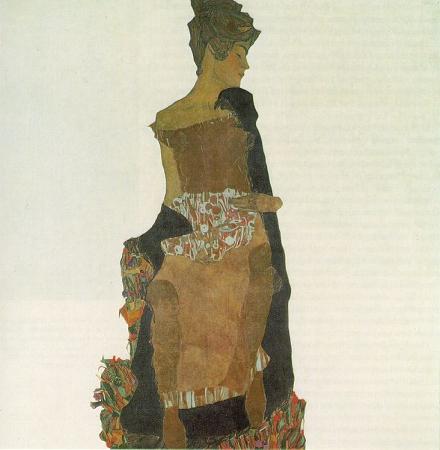Egon Schiele (1890 - 1918). Egon Schiele was an Austrian painter. A protégé of Gustav Klimt, Schiele was a major figurative painter of the early 20th century. His work is noted for its intensity and its raw sexuality, and the many self-portraits the artist produced, including naked self-portraits. The twisted body shapes and the expressive line that characterize Schiele's paintings and drawings mark the artist as an early exponent of Expressionism. Schiele was born in 1890 in Tulln, Lower Austria. As a child, Schiele was fascinated by trains, and would spend many hours drawing them, to the point where his father felt obliged to destroy his sketchbooks. When he was 11 years old, Schiele moved to the nearby city of Krems to attend secondary school. To those around him, Schiele was regarded as a strange child. Shy and reserved, he did poorly at school except in athletics and drawing, and was usually in classes made up of younger pupils. He also displayed incestuous tendencies towards his younger sister Gertrude, and his father, well aware of Egon's behaviour, was once forced to break down the door of a locked room that Egon and Gerti were in to see what they were doing. When he was sixteen he took the twelve-year-old Gerti by train to Trieste without permission and spent a night in a hotel room with her. When Schiele was 15 years old, his father died from syphilis, and he became a ward of his maternal uncle, Leopold Czihaczek, also a railway official. Although he wanted Schiele to follow in his footsteps, and was distressed at his lack of interest in academia, he recognised Schiele's talent for drawing and unenthusiastically allowed him a tutor; the artist Ludwig Karl Strauch. In 1906 Schiele applied at the Kunstgewerbeschule in Vienna, where Gustav Klimt had once studied. Within his first year there, Schiele was sent, at the insistence of several faculty members, to the more traditional Akademie der Bildenden Künste in Vienna in 1906. His main teacher at the academy was Christian Griepenkerl, a painter whose strict doctrine and ultra-conservative style frustrated and dissatisfied Schiele and his fellow students so much that he left three years later. In 1907, Schiele sought out Gustav Klimt, who generously mentored younger artists. Klimt took a particular interest in the young Schiele, buying his drawings, offering to exchange them for some of his own, arranging models for him and introducing him to potential patrons. He also introduced Schiele to the Wiener Werkstätte, the arts and crafts workshop connected with the Secession. Schiele's earliest works between 1907 and 1909 contain strong similarities with those of Klimt, as well as influences from Art Nouveau. In 1908 Schiele had his first exhibition, in Klosterneuburg. Schiele left the Academy in 1909, after completing his third year, and founded the Neukunstgruppe with other dissatisfied students. In his early years, Schiele was strongly influenced by Klimt and Kokoschka. Although imitations of their styles, particularly with the former, are noticeably visible in Schiele's first works, he soon evolved his own distinctive style. Klimt invited Schiele to exhibit some of his work at the 1909 Vienna Kunstschau, where he encountered the work of Edvard Munch, Jan Toorop, and Vincent van Gogh among others. Once free of the constraints of the Academy's conventions, Schiele began to explore not only the human form, but also human sexuality. Schiele's work was already daring, but it went a bold step further with the inclusion of Klimt's decorative eroticism and with what some may like to call figurative distortions, that included elongations, deformities, and sexual openness. Schiele's self-portraits helped re-establish the energy of with their unique level of emotional and sexual honesty and use of figural distortion in place of conventional ideals of beauty. He also painted tributes to Van Gogh's Sunflowers as well as landscapes and still lifes. In 1910, Schiele began experimenting with nudes and within a year a definitive style featuring emaciated, sickly-coloured figures, often with strong sexual overtones. Schiele also began painting and drawing children. Egon Schiele's Kneeling Nude with Raised Hands is considered among the most significant nude art pieces made during the 20th century.
more...














